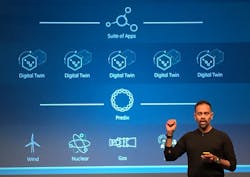One of the advantages that GE often points to in its ability to get the most out of its industrial solutions is its horizontal play in the marketplace—the factories that it has across several industries that are using the data-driven solutions that the company also markets elsewhere.
“We very much believe in the horizontal strength we call the GE story,” said GE chairman and CEO Jeff Immelt at this year’s GE Minds + Machines in San Francisco this week. But the new business models of the Industrial Internet require both a horizontal and a vertical presence, he added. “We have to add real vertical capability—a horizontal platform with vertical applications.”
One of those vertical applications, announced this week at the conference, is the Digital Power Plant. It’s the latest example of what GE is calling the Digital Twin, which combines physics-based methods with digital technologies to model an asset. The twin can then be analyzed closely to get a more exact expectation of an asset’s health, maintenance needs, lifetime, etc., providing a much more effective means of maintenance than averages collected from field experience.
“You can go back in time, understand what happened, and get better at predicting failure and preventing it,” explained Ganesh Bell, chief digital officer of GE Power & Water. “It takes the deep domain of the machine, along with the deep knowledge of our customers.”
In the case of the Digital Power Plant, a digital twin is made of the entire plant, letting utilities monitor and manage every asset to generate electricity as cleanly, efficiently and securely as possible. It combines, for example, a software-defined HA turbine with GE’s Predix platform, the Digital Twin concept and a suite of apps.
“It’s making machines software-defined—taking every capability of that machine and expressing it in software,” Bell explained. “It can make a power utility behave like a virtual battery.”
As Steve Bolze, president and CEO of GE Power & Water, pointed out during the conference, 1.3 billion people do not have access to power today. The world will require 50 percent more power in the next two decades than it does now. “We will spend, as an industry, $10 trillion to put in that new power,” he said. “It will fundamentally transform the industry that we’re in today.”
GE is tackling the power issue with data—and analysis of that data, which is not leveraged today as it could be. “As an industry, we’ve been collecting data for years,” said Dick Ayres, general manager of GE Power Generation Software Services. “But we’ve only been using about 2 percent of that data.”
How do you optimize your system? How do you bring the cost of startups down? How do you get the best operator performance? How do you take the complexity out of your assets? “Let the model run the simulations to find what the perfect operational conditions should be. The Digital Twin answers these questions,” Ayres said. “This is hugely transformative for our industry. It allows you to be more flexible, and flexibility is a huge challenge for this industry.”
Exelon Generation has entered into an agreement with GE to implement a Predix-powered suite of enterprise-wide software technologies across three fuel sources—nuclear, gas and wind. “We’re really truly digitizing all aspects of the power plant,” said Brian Hoff, director of IT, emerging technologies, for Exelon.
Hoff described the Watchtower Project, which focuses on lost MWh caused by equipment reliability and transition to condition-based monitoring at Exelon’s Byron nuclear facility in Illinois. Making proactive, data-driven decisions, Exelon has been able to reduce equipment failures and lost MWh. Exelon plans to increase the number of assets in the project at Byron and scale to additional plants in its nuclear fleet.
GE’s other launch customer, PSEG, is using GE’s software solutions to improve reliability and operational performance at multiple gas-powered plants.
A lot of wind
The Digital Power Plant is a follow-on from the Digital Wind Farm that GE launched in April. The suite of applications sitting atop GE’s Predix platform has already shown the ability to generate 20 percent more energy in a wind farm.
“We saw a need to radically re-envision wind. So we launched the Digital Wind Farm,” Bell said, describing the software-defined wind turbine. Offering more than 20 different sizes of turbine, GE is able to customize for every single pad mount. “Right off the bat, we’re able to increase wind energy by 10 percent. When we add Predix, we get another 10 percent more electricity.” That’s about $100 million in value over the life of a wind farm, Bell added.
Wind energy is classically very simplistic, according to Hunter Armistead, executive vice president of business development for Pattern Energy, which has assets in wind, solar and transmission energy. For Pattern’s Meikle Wind Project, GE modeled not only the wind turbine, but also the environment it would be in. Usually long blades win—really long blades on a really tall tower, Armistead said. “But GE figured out the best way to optimize their turbine in the environment we have.” That turned out to be a shorter blade on a shorter tower.
Pattern Energy now has a digital twin of its entire wind farm. “We’ll hopefully create a feedback loop so that, over time, we actually will be able to make these small improvements,” Armistead said. “It helps wind become a more stable and predictable part of the energy picture.”
“This is the kind of innovation we need to make renewables competitive and compelling,” Bell said.

